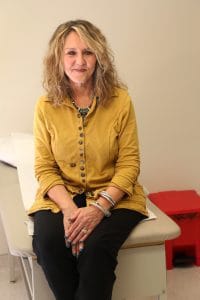Hot Springs Woman’s Hip Replacements Leave Behind Pain, Discomfort
| March 18, 2016 | In the past six months, Vicki Brooks has undergone two hip replacements, but it’s hard to tell from her energetic walk and cheerful demeanor.
If you ask Brooks, a Hot Springs resident, she praises her son, Brian, for her decision to visit UAMS when her hip pain became too much to bear.

Brooks has seen incredible improvements in her mobility and no pain since her hip replacement surgeries at UAMS.
Brooks noticed a grinding in her left hip more than a year ago, but she learned to deal with the discomfort. It was after she suffered a fall that Brooks finally decided to address the problem.
“I ended up hurting my right knee, which caused me to start limping,” she said. “It put more pressure on my left hip and caused more grinding, so I decided it was time to do something.”
That’s when her son suggested she visit one of his acquaintances — hip and knee replacement surgeon Paul Edwards, M.D., an assistant professor in the Department of Orthopaedics in the UAMS College of Medicine.
Through various tests and examinations, Edwards determined Brooks had issues in both hips due to osteoarthritis, the most common form of arthritis that affects millions of people. Osteoarthritis can occur in any joint in the body, but most commonly affects the hand, knee, hip and spine.
“In Mrs. Brooks’ case, the cartilage, or cushioned layer of her hips that surround the joint, were being damaged as a result of osteoarthritis,” said Edwards. “As the cartilage wears with time, it results in bone-on-bone rubbing, which can be extremely painful and cause inflammation that can lead to more pain.”
Brooks had her left hip replaced in August, followed by her right hip in November. Since then, Brooks said she’s been able to return to her normal daily activities with no problems.
“I’ve never had any pain, and just a little discomfort,” said Brooks. “They even had to remind me at a post-operation visit, ‘Vicki, it’s only been a few months, slow down.’”
Edwards said it’s normal for his hip replacement patients to generally experience a quick recovery, in part because of change in the rehabilitation process in recent years.
“Now, our patients stay overnight and are back in their home the next day,” said Edwards. “We think it’s critical for the patient to get back into a familiar setting where they have a strong support system that helps them through the post-operation period. Getting them home encourages early mobilization, which aids the recovery process.”
Brooks credits Edwards and the entire orthopaedics staff at UAMS with her speedy recovery.
“It’s evident that Dr. Edwards genuinely cares and takes his work seriously, I can’t say enough nice things about him,” she said. “Overall, I received wonderful care at UAMS. Everyone was kind, professional and answered any questions I had, which put me at ease throughout both operations.”
